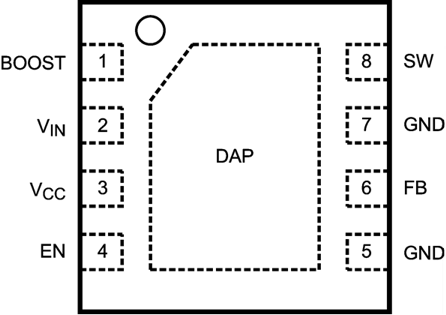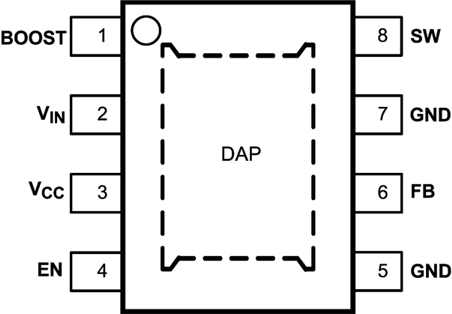SNVS556C April 2008 – January 2016 LM2738
PRODUCTION DATA.
- 1 Features
- 2 Applications
- 3 Description
- 4 Revision History
- 5 Pin Configuration and Functions
- 6 Specifications
- 7 Detailed Description
-
8 Application and Implementation
- 8.1 Application Information
- 8.2
Typical Applications
- 8.2.1 LM2738X Circuit Example 1
- 8.2.2 LM2738X Circuit Example 2
- 8.2.3 LM2738X Circuit Example 3
- 8.2.4 LM2738X Circuit Example 4
- 8.2.5 LM2738X Circuit Example 5
- 8.2.6 LM2738Y Circuit Example 6
- 8.2.7 LM2738Y Circuit Example 7
- 8.2.8 LM2738Y Circuit Example 8
- 8.2.9 LM2738Y Circuit Example 9
- 8.2.10 LM2738Y Circuit Example 10
- 9 Power Supply Recommendations
- 10Layout
- 11Device and Documentation Support
- 12Mechanical, Packaging, and Orderable Information
5 Pin Configuration and Functions
NGQ Package
8-Pin WSON With Exposed Thermal Pad
Top View

DGN Package
8-Pin MSOP-PowerPAD
Top View

Pin Functions
| PIN | TYPE(1) | DESCRIPTION | |
|---|---|---|---|
| NO. | NAME | ||
| 1 | BOOST | I | Boost voltage that drives the internal NMOS control switch. A bootstrap capacitor is connected between the BOOST and SW pins. |
| 2 | VIN | PWR | Supply voltage for output power stage. Connect a bypass capacitor to this pin. Must tie pins 2 and 3 together at package. |
| 3 | VCC | I | Input supply voltage of the device. Connect a bypass capacitor to this pin. Must tie pins 2 and 3 together at the package. |
| 4 | EN | I | Enable control input. Logic high enables operation. Do not allow this pin to float or be greater than VIN + 0.3 V. |
| 5, 7 | GND | PWR | Signal and power ground pins. Place the bottom resistor of the feedback network as close as possible to these pins. |
| 6 | FB | I | Feedback pin. Connect FB to the external resistor divider to set output voltage. |
| 8 | SW | O | Output switch. Connects to the inductor, catch diode, and bootstrap capacitor. |
| DAP | GND | — | Signal and power ground. Must be connected to GND on the PCB. |
(1) I = Input, O = Output, and PWR = Power